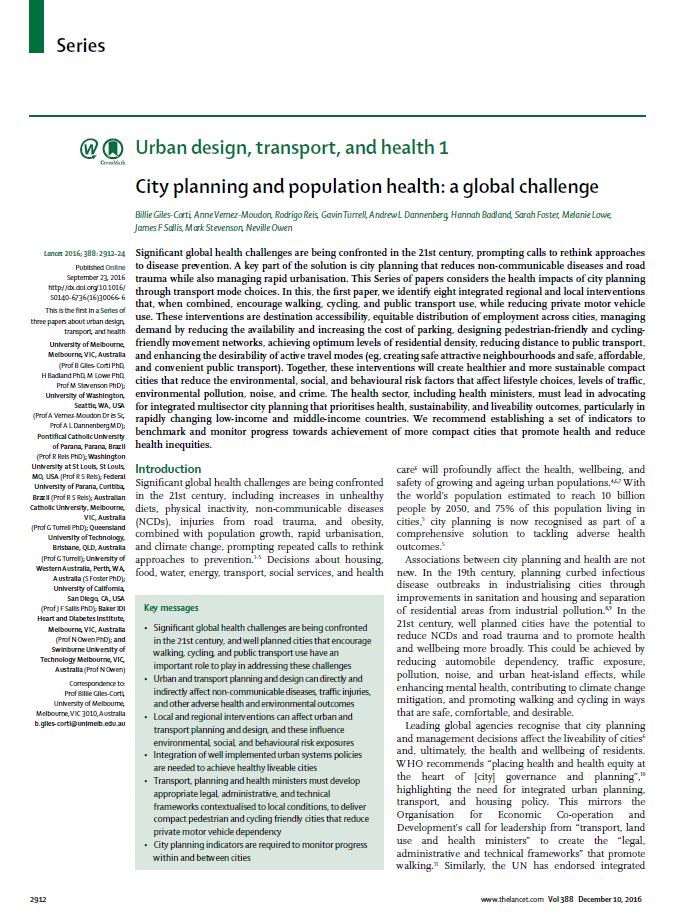City planning and population health: A global challenge
Significant global health challenges are being confronted in the 21st century, prompting calls to rethink approaches to disease prevention. A key part of the solution is city planning that reduces non-communicable diseases and road trauma while also managing rapid urbanisation.
Billie Giles-Corti,1 Anne Vernez-Moudon,2 Rodrigo Reis3 4 5, Gavin Turrell6 7, Andrew Dannenberg2, Hannah Badland1, Sarah Foster8, Melanie Lowe1, James Sallis9, Mark Stevenson1, Neville Owen10 11
The Lancet, Vol. 388, Issue 10062
Abstract
Significant global health challenges are being confronted in the 21st century, prompting calls to rethink approaches to disease prevention. A key part of the solution is city planning that reduces non-communicable diseases and road trauma while also managing rapid urbanisation. This Series of papers considers the health impacts of city planning through transport mode choices. In this, the first paper, we identify eight integrated regional and local interventions that, when combined, encourage walking, cycling, and public transport use, while reducing private motor vehicle use. These interventions are destination accessibility, equitable distribution of employment across cities, managing demand by reducing the availability and increasing the cost of parking, designing pedestrian-friendly and cycling-friendly movement networks, achieving optimum levels of residential density, reducing distance to public transport, and enhancing the desirability of active travel modes (eg, creating safe attractive neighbourhoods and safe, affordable, and convenient public transport). Together, these interventions will create healthier and more sustainable compact cities that reduce the environmental, social, and behavioural risk factors that affect lifestyle choices, levels of traffic, environmental pollution, noise, and crime. The health sector, including health ministers, must lead in advocating for integrated multisector city planning that prioritises health, sustainability, and liveability outcomes, particularly in rapidly changing low-income and middle-income countries. We recommend establishing a set of indicators to benchmark and monitor progress towards achievement of more compact cities that promote health and reduce health inequities.
Author Affiliations
1University of Melbourne, Melbourne, VIC, Australia; 2University of Washington, Seattle, WA, USA; 3Pontifical Catholic University of Parana, Parana, Brazil; 4Washington University at St Louis, MO, USA; 5Federal University of Parana, Curitiba, Brazil; 6Australian Catholic University, Melbourne, VIC, Australia; 7Queensland University of Technology, Brisbane, QLD, Australia; 8University of Western Australia, Perth, WA, Australia; 9University of California, San Diego, CA, USA; 10Baker IDI Heart and Diabetes Institute, Melbourne, VIC, Australia; 11Swinburne University of Technology, Melbourne, VIC, Australia
Citation
Giles-Corti, B., Vernez-Moudon, A., Reis, R., Turrell, G., Dannenberg, A. L., Badland, H., . . . Owen, N. (2016). City planning and population health: a global challenge. The Lancet, 388(10062), 2912-2924. doi:https://doi.org/10.1016/S0140-6736(16)30066-6
